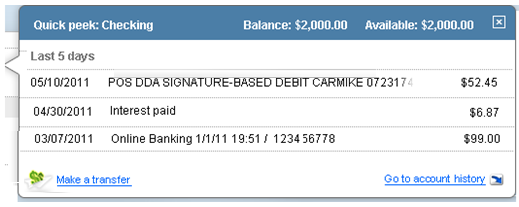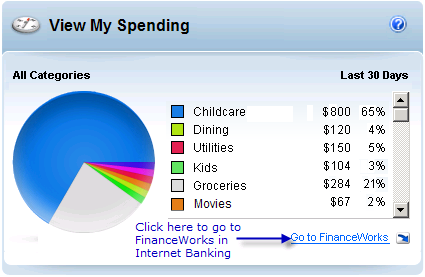Welcome to the Online Banking Home Page
Several commonly asked questions about the Online Banking Home Page are presented below as jump links and
should help get you up to speed using this page. Scroll through the topics or use the links below to get
the information you need most.
What is the Online Banking Home Page?
What's on the Online Banking Home Page?
Can I copy and paste transactions into a spreadsheet?
Can I do a browser search on the Home Page?
How can I get to other pages in Internet Banking from the Home Page?
Where can I check my account balances?
Where can I find when my CD or Certificate Account matures?
Where can I find my transactions?
How do I hide or show my accounts?
How can I make a one-time transfer using Move Money?
How do I make a loan payment using Move Money?
How long does it take for transfers to display?
How do I add outside accounts?
How do I pay my bills?
Why did I get a payment reminder for a bill I already paid using Make a Payment?
How do I use Rewards program offers?
How do I use the Rewards program summary page?
Where can I check my spending?
Why are some transactions on My Accounts not in the spending chart?
Where can I find my detailed account history?
Where can I find my full account number?
Where can I see my check images?
How do I print out my transactions and check images?
How do I create or change nicknames for my accounts?
How do I change the order of my accounts?
What is the Online Banking Home Page?
The Online Banking Home Page helps you do your everyday money management tasks quickly and easily all in one place.
In fact, we've brought together the tools needed to perform your most common daily tasks without ever leaving
the page. You can easily:
- Check all of your account balances at once
- Take a quick peek at your most recent transactions
- Make a one-time transfer between your accounts
- Make a loan payment within My Accounts
- Schedule a one-time bill payment
- Find and use Rewards program offers
- See where you are spending your money
So instead of switching between Account Summary, Account History, Bill Pay, Transfer Funds and other pages, you
can take action right there on one page to complete several basic functions. We hope you will think of it as your money
management control panel.
NOTE: If you do not have any accounts set up in online banking yet, the page will just display
the message, "You do not currently have any accounts."
Back to top
What's on the Online Banking Home Page?
The Online Banking Home Page contains task-specific areas that are usually found individually on several different pages within
Internet Banking: Account Summary, Account History, Bill Pay, Transfer Funds and FinanceWorks. NOTE: If you do not
have any accounts set up in online banking yet, the page will just display the message, "You do not currently have any
accounts."
My Accounts
This is where you can see all of your accounts and balances in a glance without having to scroll. In the upper-right
portion of My Accounts you will find the Make a transfer icon and link that enables you to make a one-time funds
transfer between your accounts and much more. To view the most recent activity for any account, click the Quick
Peek link. Clicking Quick Peek opens a new window that shows the most recent transactions or payment activity
for the account along with links to Make a Transfer and Go to account history.
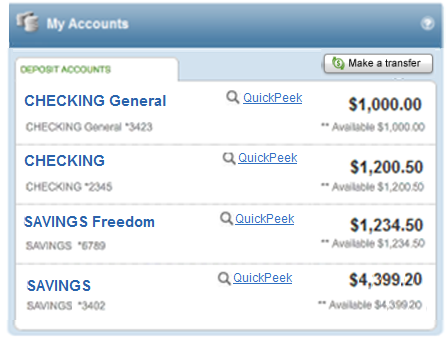
Make a transfer
Just select the Make a transfer button to make a one-time transfer between your accounts. You may also be able to transfer funds to make a loan payment, if that option is available. If there are any restrictions on the number of transfers allowed
per month or any transfer fees applied, it will be indicated in a message displayed below the To or From field (or both).
Selecting the Make a transfer button opens the Move Money window above the My Accounts list. Just enter the amount,
select the transfer To and From accounts, then click the Transfer button and confirm the
transfer details and you're done. Transactions now post quickly when you complete a transfer. This means that we will
automatically refresh the page (to get the new account balances) when you close the transfers success window.
NOTE: If you are making a loan payment, additional fields may be available
to enter the required information. Click here to learn more about making a loan payment. If available, additional transfer options may be found within the main Internet Banking pages.
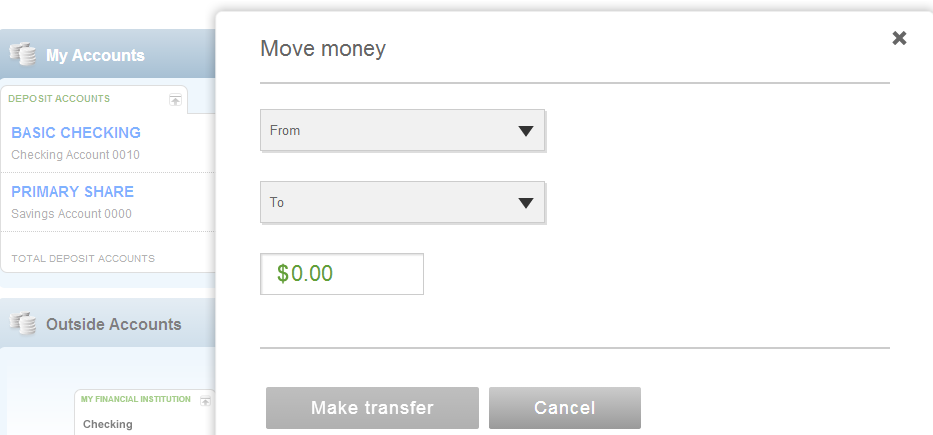
Make a Payment
If you are already using Bill Pay in Internet Banking, you can schedule a one-time payment here. First select a payee from
the drop-down field, then select the payment date using the calendar tool and enter the amount. Then click the Schedule
payment button to schedule the payment. Schedule payments that haven't yet been paid are also displayed here.
If you are not yet a Bill Pay user, the Make a Payment section will display a message about
paying bills online. Just click the Go to payments link below the message to go to the Bill Pay enrollment page.
Click here to see the step-by-step process for setting up a one-time bill payment
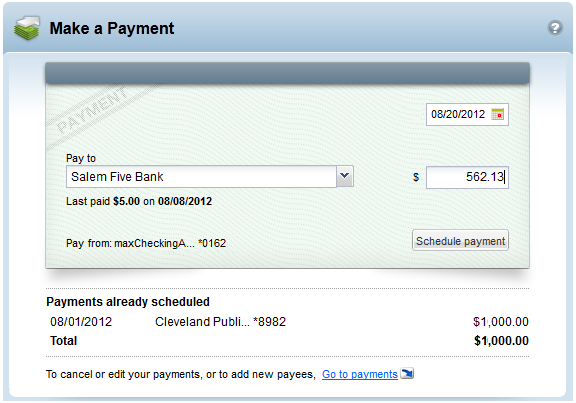
Rewards program
The Rewards program is an easy way to put a little money back in your pocket just by shopping for things you already use.
If an account is eligible for the Rewards program you will see offers in your transaction list and find the 'Rewards'
section just below the account summary. Clicking the View your offers link opens the Rewards program summary
page with a list of all new and current offers and recent rewards.
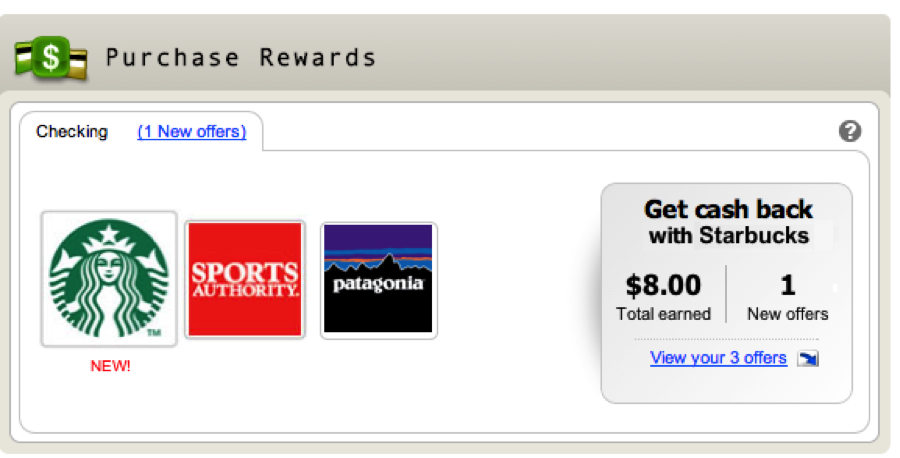
View My Spending
If you are a FinanceWorks user, the pie chart shows all of your spending trends with
a summary of your transactions for the past 30 days, categorized and broken out as totals
and percentages. You can click on a pie piece to see a complete list of transactions for the
selected category.
If you are not yet a FinanceWorks user, instead of seeing the spending pie chart a message
will encourage you to try FinanceWorks. Just click the link below the message to go to FinanceWorks
and get started.
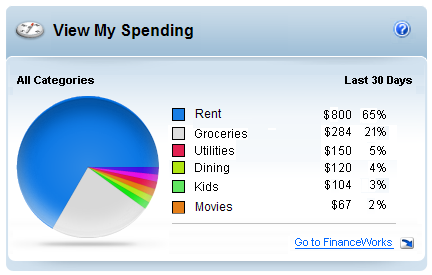
Back to top
How can I get to other pages in Internet Banking from the Home Page?
You can use your standard menu and submenu selections to navigate around Internet Banking like you
do now. However, each section of the Online Banking Home Page has a link that will take you to other pages
within Internet Banking that may help you do things that are not currently available on the page.
- In the My Accounts section you will find a Quick Peek link to the right of
each account name. Clicking the link opens a new window listing the most recent transactions.
At the bottom of the window you will find a Go to account history
link, which, when selected opens the Account History Page for that
account.
- The View My Spending section has a Go to FinanceWorks link
below the spending chart. Clicking that link opens the main FinanceWorks
page within Internet Banking where you can categorize
transactions, set spending and savings goals for today and the future.
- At the bottom of the Make a Payment section you will find a
go to payments link. Clicking this link opens the main Bill Pay page
within Internet Banking. This is where you can add, edit
and delete payees, set up recurring payments and other Bill Pay-related tasks.
Back to top
Can I copy and paste transactions into a spreadsheet?
Yes you can copy data from the transaction list and paste it into standard spreadsheets like Excel. Just highlight and
copy the data you want (e.g., date, description or amount) from Quick Peek and paste it into a row of the spreadsheet.
Back to top
Can I do a browser search on the Home Page?
Yes, you can use Control + F to do a simple browser search for an amount, date, payee name, etc. within Quick
Peek. For example, just open the browser search field (Ctl F) enter the payee name and click the Next button.
Back to top
Where can I check my account balances?
The My Accounts section in the upper left area has all of
your accounts categorized by type (Deposit, Savings, Loans, etc.) with the current balance
and available balance for each account. Within each category group the accounts are listed in
alphabetical order by name – either the original account name or the account nickname
that you assigned.
Your first Deposit account is displayed at the top of the list and shows the balance and available balance. The
Total Accounts value is displayed at the bottom of each account section.

Back to top
Where can I find when my CD or Certificate Account matures?
If available with your online services, you will be able to see the maturity date of your CD or Certificate Account in
the account bar without having to access the account details. If the maturity date is available, it is
displayed as “Matures on MM/DD/YYYY.”
Back to top
Where can I find my transactions?
Clicking Quick Peek opens a new window that shows the balance and available balance along with the most
recent transactions or payment activity for that account. High transaction volume accounts (like Checking) will show
5 days of account activity. Low volume accounts (like loans) will show 30 days of account activity. You will also find
helpful links to Make a Transfer and Go to account history at the bottom of the window.
Just click the X button on the top right or anywhere outside of the window to close it. Clicking the account name
or the Go to account history link opens the Account History Page for that account.
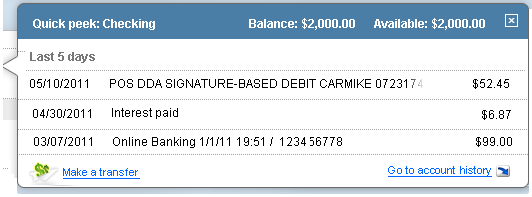
For all loan accounts you will see the balance, next payment amount, a Pay now link (to make the loan payment),
interest paid for the current and previous years, recent payments made, and a link to the account history page. Clicking the
Pay now link will open the Move money window so you can complete the payment.

Back to top
How do I hide or show my accounts?
It couldn't be easier. Just click on the arrow icon that's located to the right of the account category name to hide all of the accounts for that category.
Simply click on the arrow icon again to redisplay the accounts.

Back to top
How can I make a one-time transfer using Move Money?
In the upper right portion of the My Accounts section you will see the Make a
Transfer button. Clicking the button opens the Move Money window. Select the From and To accounts,
enter the transfer amount, then click the Transfer button. If it applies, the number of
transfers available and number of transfers used for the month will be displayed below the account field.

When you click the Transfer button you will get a message asking you to confirm the funds transfer, as seen in
the example below.

When you click the Make Transfer button a transfer complete window will display with all of the relevant transfer
details and the option to Make another transfer or Print the transfer details. Transactions will post immediately
when you complete the transfer.
This means that we will automatically refresh the page (to get new account balances) when you close the transfers success
window shown below. NOTE: If an issue should occur during the transfer process, an error message will instruct you
what to do next.
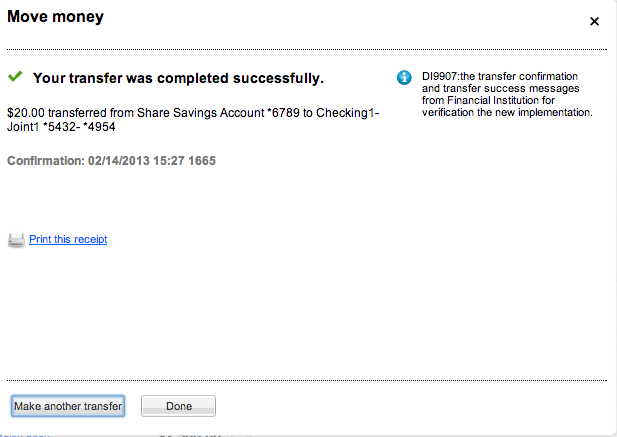
Back to top
How do I make a loan payment using Move Money?
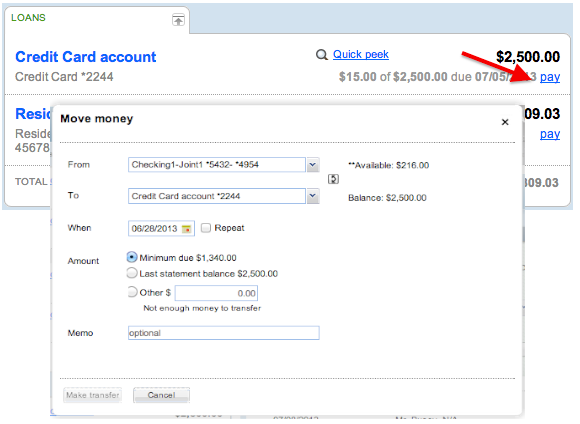
To make a loan payment using Move Money:
- Click the Pay link to open the Move Money window
- Select the From account from the drop-down list (the Available dollar amount will be displayed)
- Select the To account from the drop-down list (the Balance amount will be displayed)
- Review the Amount to be paid
- Click the Transfer button and review the payment details
- Click the Make Transfer button to complete the payment and display the payment details
- Click Make another transfer to make another transfer or payment, click Print confirmation to print out
the payment details, or click Close to close the Move Money window
Back to top
How long does it take for transfers to display?
Transfers made on the Online Banking Home Page will display quickly in the My Accounts list and the Account History
Page transactions list if it's supported. This means that we will automatically refresh the page
(to get new account balances) once a user closes the transfers success window.
Back to top
How do I add outside accounts?
Adding outside accounts if you are not enrolled in FinanceWorks
If you are not a FinanceWorks user, you will see the promotional spot in the Outside Accounts module,
as shown below. Just click the Get Started link to open the FinanceWorks enrollment page, then follow
the onscreen instructions to sign up for free. See the details for adding your outside accounts below.
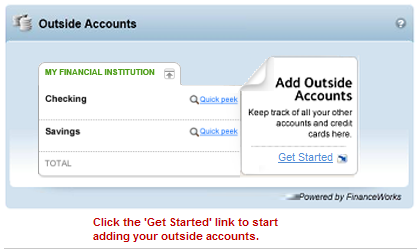
Adding outside accounts for a FinanceWorks user that has no accounts added yet
Once you have signed up for FinanceWorks, you can start adding your outside accounts (checking, savings,
investments, etc.) so they will be available within FinanceWorks and the Outside Accounts module
on the Online Banking Home Page. Within FinanceWorks, outside accounts can be added on the Overview page.
To begin adding outside accounts from the Online Banking Home Page, click the Add Outside Accounts link in the
Outside Accounts module to directly access the Financial Institution Search page in FinanceWorks.
Start typing the financial institution name or account name in the field provided, as shown below. Matching
names will automatically display below the entry field, so just click on the name you want to select it.
Clicking on the account name opens a new window where you will enter your User ID and Password. This enables
FinanceWorks to automatically access your account data and display it in the Accounts column, as well as
the Outside Accounts module on the Online Banking Home Page. Simply follow the on-screen instructions to add each bank
or account.
NOTE: You only have to enter your account login information once for everything you set up, except
for a Wells Fargo account. You will have to enter your Wells Fargo login credentials every time you access
FinanceWorks.
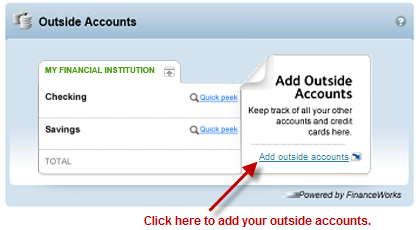
Adding additional accounts in the Outside Accounts module
So what types of financial institutions and accounts can be added? You can add an outside bank, credit union,
or investment firm from more than 18,000 financial institutions from across the country. You can
also add a variety of accounts: Checking, CD or Certificate Account, Money Market, Savings, Mortgage, Loan, Line of
Credit, Taxable Investments and Tax-deferred Investments (that may include securities like stocks, bonds,
mutual funds and cash reserves).
The accounts will be organized by financial institution with all available accounts listed for each one, as
shown below. There will be a hide/show arrow icon to the right of the financial institution name. Clicking
on the arrow icon will open a collapsed group of accounts, or collapse an account set that is open.
When you have added one or more accounts the Outside Accounts module will look more like what you see below.
To add an additional financial institution or account, simply click the Add button to directly access
the Financial Institution Search page within FinanceWorks.
Each account will display a "Last updated" date and time below the account balance. If FinanceWorks cannot
connect to an account, a warning sign is displayed with the following message, "We cannot connect to this
account." Clicking on the How do I fix this? link displays specific instructions of how to use the
Go to FinanceWorks link to remedy the issue there.

Back to top
How do I pay my bills?
At the top of the right column is the Make a Payment section. It looks
a bit like a check and can be easily used to schedule a new payment.

Use the following steps to schedule a new payment:
- Click the drop-down button on the Pay to field to see all of the payees.
(i.e., all of the payees you already have set up in Bill Pay)
- Click a name on the list to select it. (If a payment has been made to that payee in
the last 90 days, it will appear below the payee name)
- Click the date field and select the payment date from the calendar. When the calendar closes
the date will be automatically entered into the field. (Dates in the past, weekends and bank holidays
cannot be selected)
- Enter a dollar amount in the $ amount field and click the Schedule payment button
- Review the confirmation message to make sure everything is correct
- Click the Yes button to complete the payment
- A success message and the scheduled payment will appear in the Payments already scheduled list. (The
Payments already scheduled list displays all payments that have been scheduled but have not yet been
sent)
NOTE: If for any reason the payment cannot be scheduled, an error message will display and tell
you what to do next.
If you are not yet set up for bill pay, the Make a Payment task area will display
a message encouraging you to start paying your bills online. Clicking the Go to Payments link
will take you to the Bill Pay start page.
Back to top
Why did I get a payment reminder for a bill I already paid using Make a Payment?
We are experiencing a temporary communication issue with the main Bill Payment system meaning it does not recognize
payments made through Make a Payment on the Online Banking Home Page. You may have even received an email reminder to pay
the same eBill that you just paid using Make a Payment. Please go to the main Bill Pay system and file that eBill to resolve
the issue.
Back to top
How do I use the Rewards program offers?
If an account is eligible for Rewards program and offers are available for that account, you may find offers
in your transactions list. If there is an offer attached to a particular transaction, the offer will appear
on the second line of the transaction details, as shown below.
The yellow section in the transaction history example below shows a “New Offer” that has not been added to your card.
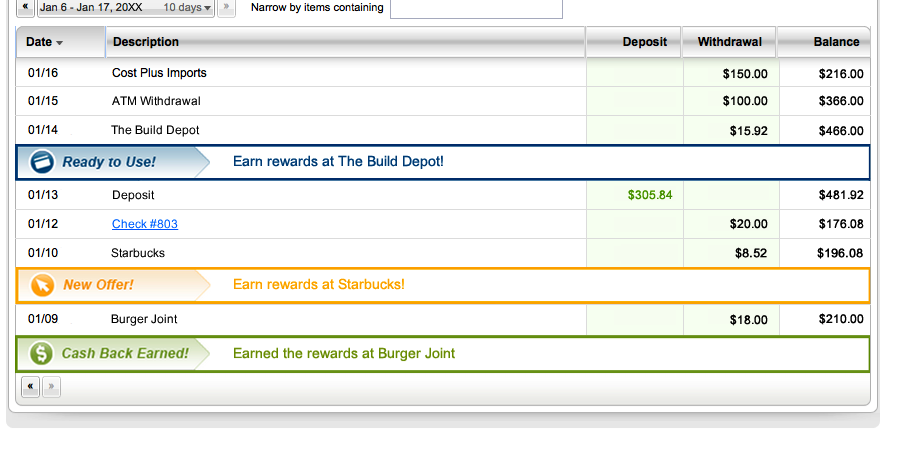
Activating an offer
When you click on the yellow section, the offer will expand and automatically add the offer to the debit card associated with
the account, as shown below. Then when you shop at the sponsoring merchant and use that debit card to pay for the transaction,
you earn the reward.
You can also read the full offer details there on the page or click the View All Offers icon to go to your
Rewards Summary page.
Back to top
How do I use the Rewards program summary page?
You'll notice right away that the summary page is arranged in three tabs: Recent Offers, Expired Offers and Rewards Earned.
You'll find a list of every new and active offer for that account in the Recent Offers tab with the most recent
arrivals at the top of the list. Clicking on a Merchant Logo puts the offer on your debit card.
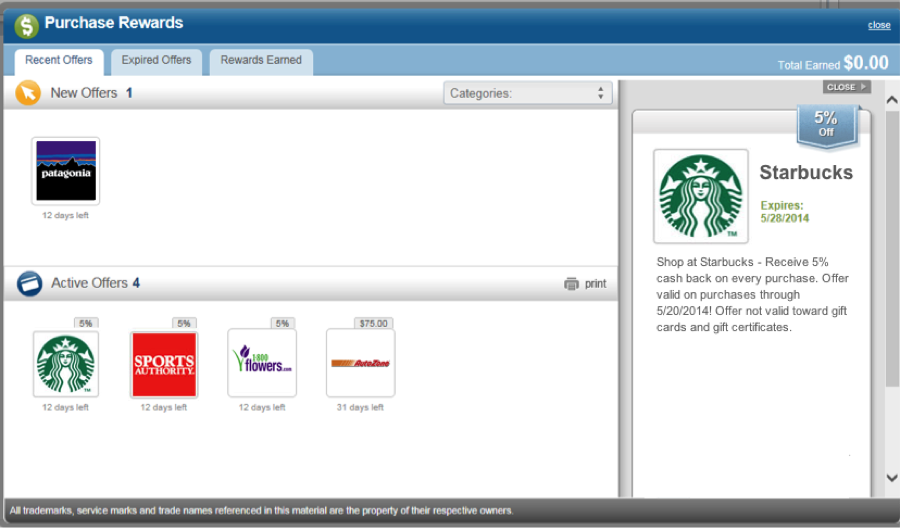
You can review all of the offers that have expired in the Expired Offers tab. Clicking on a Merchant Logo shows the complete
offer details.

You can also see how much you have earned in the Rewards Earned tab. These redeemed offers are arranged by month. This is how it
works, if you make a qualifying purchase with your debit card in April, it will be shown in the Rewards Earned
column as being deposited into your account at the end of May.
Opting Out of the Rewards Program
If you decide that you want to opt out of the Rewards program for a specific account, just click the
Stop receiving all offers link near the bottom of the page and click Yes in the resulting
popup to confirm that you no longer wish to receive offers for that account. NOTE: To start seeing
offers again, click the Get Started link at any time in the Rewards module to opt back in to the Rewards program.
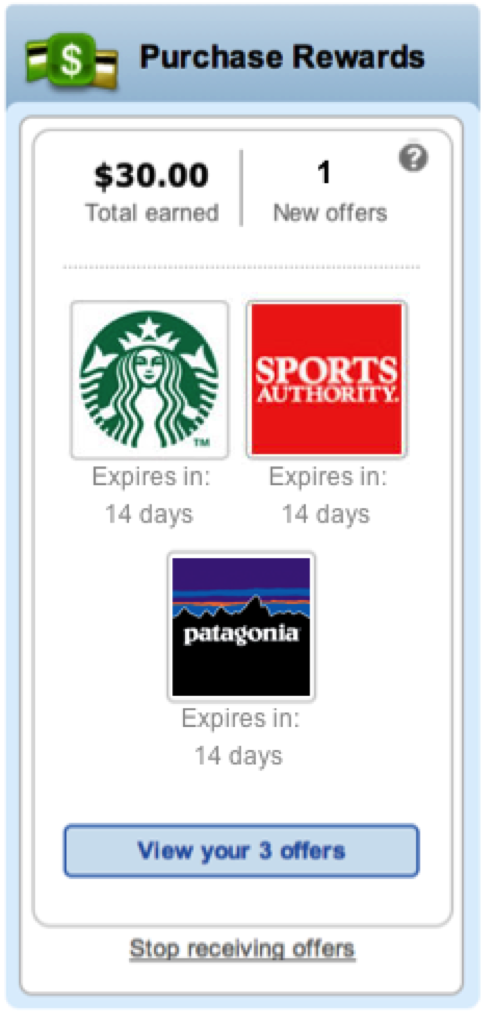
Back to top
Where can I check my spending?
If you are a FinanceWorks user, you will see the familiar pie chart in the View My Spending section. The pie chart is created with
your transaction data that comes directly from FinanceWorks. It shows your spending over the past 30 days
and each spending category that you have used is represented by a slice of the pie.
The pie slice categories are listed in a legend next to the chart and show the total value and percentage
of the total amount. Please be aware that only Personal spending categories – and NOT those categorized as
Business expenses – will appear in the spending chart.

Resting or hovering your mouse over one of the pie slices, displays the category name, total amount
and percentage in a pop-up, as seen below.
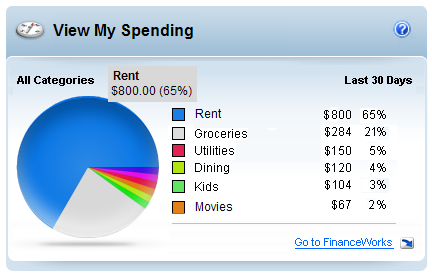
Now click the slice to refresh the chart and show the transactions that make up that category as pie
slices and legend information. When you want to see all the main categories again, just click the
All Categories link above the chart.
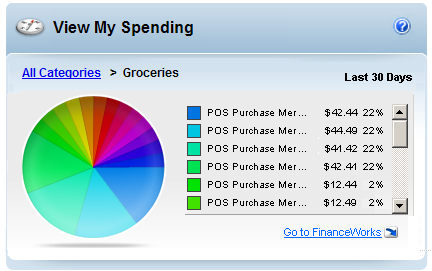
If you are not yet a FinanceWorks user, instead of the spending pie chart you will see a message
encouraging you to sign up. Just click the Go to FinanceWorks link or icon to get started, if
it is available.
Back to top
Why are some transactions on My Accounts list not in the spending chart?
The transactions shown in the spending chart are collected every night from your
different accounts by FinanceWorks. But in some cases it may take a day or two for transactions
to appear in the chart. FinanceWorks may not be able to get the transactions from one or more
of your accounts (e.g., if an account is offline and doesn't respond). In those cases, FinanceWorks
won't be able to retrieve transactions from that account until the error is fixed.
Hint: If you would
like to ensure that all available transactions are displaying in the pie chart, click on the
Go to FinanceWorks link at the bottom of the View My Spending
section. Once in FinanceWorks, click the Refresh button in the upper left part of the page to
download your latest transactions. Once the page reloads, your latest transactions should be included
in the chart.
Back to top
Where can I find my detailed account history?
Just click the account name link that you want to open the Account History Page. The page will open with transaction
details for your default date range. Or you can click on the Go to account history link in the Quick Peek window
to directly access the Account History Page.
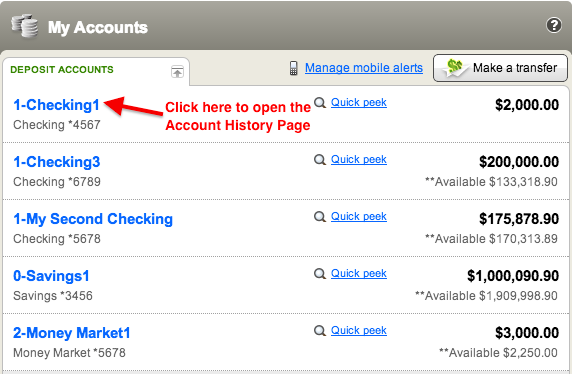
Back to top
Where can I find my full account number?
If we do not mask account numbers, you can go to the account you want and click the account name link to open the Account History Page.
Click the See account details link in the account summary window in the upper right-hand part of the
screen. If it's available and not masked, your full account number will be listed with other relevant account details.
When you are finished just click the Hide account details link to collapse the extra information.
(NOTE: Your account number can also be found at the bottom of a physical check. It's the last 7-10 numbers
on the right side.)
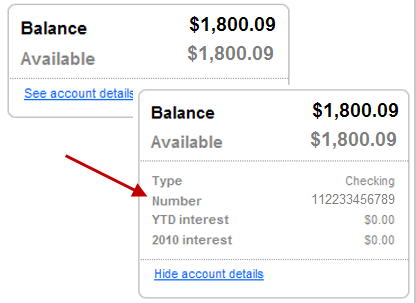
Back to top
Where can I see my check images?
First go to the My Accounts area and find the account you're looking for. Click the
account name link for that account to open the Account History Page. The check will display as a link, typically with
the check number. Simply click the link to view images of the front and back of the check. Click the
Close button at the bottom of the window when you are finished.
Back to top
How do I print my transactions and check images?
First go to the My Accounts area and find the account you're looking for. Click the
account name link for that account to open the Account History Page.
Print Transactions: Make sure the date range is what you want (e.g., 30 days) or select a different
date range using the Change drop-down list. Click the Print icon or link to open a separate
window showing the transactions in a printer friendly format. Select a printer, if needed, and click the
Print button to send the transaction list to the printer.
Print Check Images: In the Account History Page, open the account that you want and then click
the check link that you want to print. With the check images displayed, click the Print icon or link.
Select a printer, if needed, then click the Print button to send the check images to the printer.
Back to top





